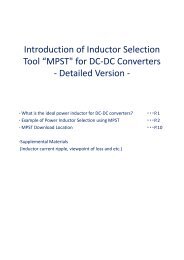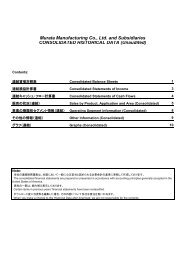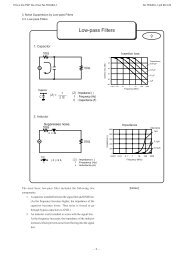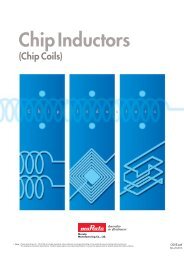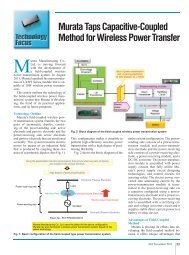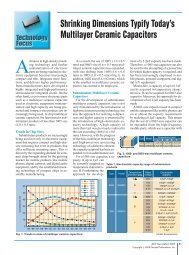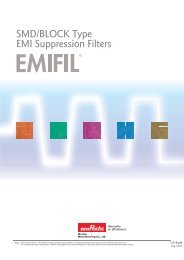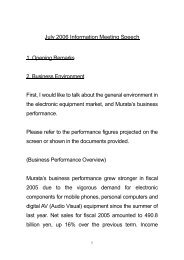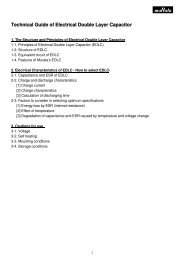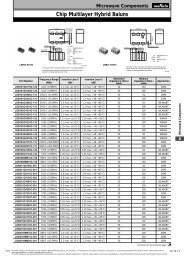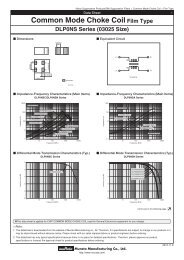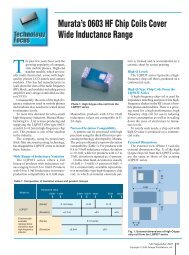Safety Standard Certified Ceramic Capacitors/High Voltage ... - Murata
Safety Standard Certified Ceramic Capacitors/High Voltage ... - Murata
Safety Standard Certified Ceramic Capacitors/High Voltage ... - Murata
Create successful ePaper yourself
Turn your PDF publications into a flip-book with our unique Google optimized e-Paper software.
!Note • Please read rating and !CAUTION (for storage, operating, rating, soldering, mounting and handling) in this catalog to prevent smoking and/or burning, etc.• This catalog has only typical specifications. Therefore, please approve our product specifi cations or transact the approval sheet for product specifi cations before ordering.C85E.pdfApr.7,2014DEH Series Specifications and Test MethodsNo.ItemSpecificationsTest Method1 Operating Temperature Range -25 to +125°C2 Appearance and Dimensions4512DielectricStrengthInsulationResistance (I.R.)7 Dissipation Factor (D.F.)9 Strength of Lead10 VibrationResistance11 Solderability of LeadsSoldering Effect(Non-Preheat)Between LeadWiresBody InsulationBetween LeadWires8 Temperature CharacteristicsPullBendingAppearanceCapacitanceD.F.AppearanceCapacitanceChangeDielectric Strength(Between LeadWires)No visible defect, and dimensions arewithin specified range.3 Marking To be easily legibleNo failureNo failure10000MΩ min.6 Capacitance Within specified toleranceChar. R: 0.2% max.Char. C: 0.3% max.T. C.RCNo marked defectWithin ±10%Per item 4.Temp. Char.-25 to +85°C +85 to +125°CWithin ±15%Within +15/-30%Within ±20%No marked defectStepTemp. (°C)Lead wire should not be cut off.Capacitor should not be broken.Within specified toleranceChar. R: 0.2% max.Char. C: 0.3% max.120±2Lead wire should be soldered withuniform coating on the axial directionover 3/4 of the circumferential direction.2-25±3320±2*1"Room condition" Temperature: 15 to 35°C, Relative humidity: 45 to 75%, Atmospheric pressure: 86 to 106kPaThe capacitor should be visually inspected for evidence ofdefect. Dimensions should be measured with slide calipers.The capacitor should be visually inspected.The capacitor should not be damaged when DC voltage of200% of the rated voltage (DC1 to 3.15kV) or DC voltage of250% of the rated voltage (DC500V) is applied between thelead wires for 1 to 5 sec.(Charge/Discharge currentV50mA)The capacitor is placed in the container withmetal balls of diameter 1mm so that eachlead wire, short circuited, is kept about 2mmoff the metal balls as shown in the figure atright, and AC1250V(r.m.s.) isapplied for 1 to 5 sec. between capacitorlead wires and metal balls.(Charge/Discharge currentV50mA)The insulation resistance should be measured withDC500±50V within 60±5 sec. of charging.The capacitance should be measured at 20°C with 1±0.2kHzand AC5V(r.m.s.) max.The dissipation factor should be measured at 20°C with1±0.2kHz and AC5V(r.m.s.) max.The capacitance measurement should be made at each stepspecified in the Table.Pre-treatment: Capacitor should be stored at 125±3°C for 1 hr., then placed atroom condition* for 24±2 hrs. before measurements.4125±2520±2As shown in the figure at right, fix the body ofthe capacitor and apply a tensile weightgradually to each lead wire in the radialdirection of the capacitor up to 10N (5N forlead diameter 0.5mm), and keep it for 10±1sec.Each lead wire should be subjected to 5N (2.5N for leaddiameter 0.5mm) of weight and bent 90° at the point of egress,in one direction, then returned to its original position and bent90° in the opposite direction at the rate of one bend in 2 to 3sec.The capacitor should be firmly soldered to the supporting leadwire and vibrated at a frequency range of 10 to 55Hz, 1.5mm intotal amplitude, with about a 1-minute rate of vibration changefrom 10Hz to 55Hz and back to 10Hz. Apply for a total of 6 hrs.,2 hrs. each in 3 mutually perpendicular directions.The lead wire of a capacitor should be dipped into a ethanolsolution of 25wt% rosin and then into molten solder for 2±0.5sec. In both cases the depth of dipping is up to about 1.5 to2mm from the root of lead wires.Temp. of solder: Lead Free Solder (Sn-3Ag-0.5Cu) 245±5°CH63 Eutectic Solder 235±5°CThe lead wire should be immersed into the melted solder of350±10°C up to about 1.5 to 2mm from the main body for3.5±0.5 sec.Pre-treatment:Capacitor should be stored at 125±3°C for 1 hr., then placedat room condition* for 24±2 hrs. before initial measurements.Post-treatment:Capacitor should be stored for 24±2 hrs. at room condition.*WAbout 2mmMetal balls7Continued on the following page.39




